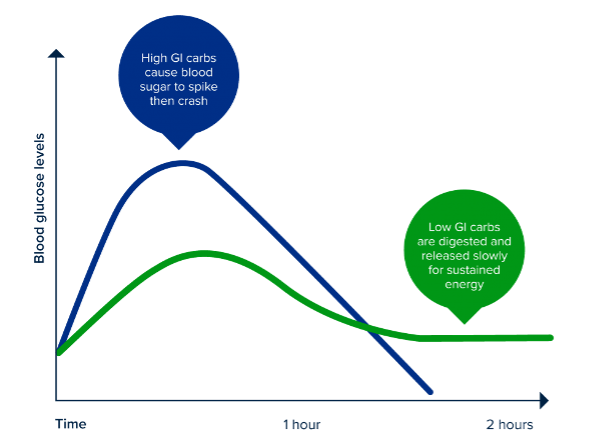Glycemic Index
What is the Glycemic Index?
The Glycemic Index (GI) is a ranking of carbohydrate foods on a scale of 0 to 100 based on their effect on blood glucose (sugar) levels:
- Low GI: <55
- Intermediate GI: 56 – 69
- High GI: >70
High GI vs Low GI
High GI carbohydrates are quickly digested and absorbed, causing a quick increase in blood sugar levels followed by a quick drop. Carbohydrates with a low GI are a better choice as they are slowly digested and absorbed, producing a slow rise in blood sugar levels. This helps to give us long-lasting energy and keeps us feeling fuller for longer.
Lowering the GI of your diet can help to prevent and manage overweight and obesity, and reduces risks of type 2 diabetes, heart disease and some cancers.

Simple Swaps
| Category | Instead of these higher GI options | Swap with these lower GI options |
| Breads | White bread Wholemeal bread Dark or light rye Bagels Turkish bread English muffins White tortillas Crumpets | Multigrain and seed breads Traditional sourdough Wholegrain high fibre wraps White corn tortillas Wholemeal pita |
| Breakfast Cereal | Refined puffed or flaked cereal Instant oats | Rolled oats Steel cut oats Untoasted muesli Wholegrain or multigrain high fibre cereals |
| Rice | Jasmine Arborio (risotto) Medium grain white rice Medium grain brown rice | White or brown long grain rice such as Basmati Wild rice Black or red rice |
| Grains | Polenta Couscous | Quinoa Barley Bulghur Pearl couscous Semolina Buckwheat |
| Pasta & Noodles | Potato gnocchi Rice pasta Corn pasta Instant noodles Dried rice noodles | Wheat pasta Vermicelli Soba noodles Hokkien noodles Fresh rice noodles |
| Savoury Snacks | Rice crackers Rice cakes Water crackers Puffed crispbread Potato chips Pretzels | Wholegrain crackers Nuts Dry roasted chickpeas Baked beans Vegetable sticks with hommus |
| Milk & Yoghurt | Rice milk Oat milk | Milk Yoghurt Soy milk Soy yoghurt |
| Sweet Snacks | Biscuits Doughnuts Cakes Pastries Muffins | Fresh fruit Fruit bread Small fruit smoothie |
| Sweeteners | Sugar Treacle Golden syrup Rice malt syrup Brown rice syrup Corn syrup | Fruit Honey Maple syrup |
What about Glycemic Load?
The Glycemic Load (GL) looks at both the GI of a food and the amount of carbohydrates per serve to give a better picture of the effect of a food on blood sugar levels. For example, although pasta has a low GI, a large serving can still cause a quick rise in blood sugar levels due to the overall amount of carbohydrates eaten.
The GL of a food can be classified as low, medium or high:
- Low: ≤10g
- Medium: 11 – 19g
- High: ≥20g
GL is calculated using the following formula:

For example, an apple has a GI of 38 and contains 13g of carbohydrates.
GL = 38 x 13 / 100 = 5g (low GL)
The higher the GL, the greater the expected rise in blood sugar levels, so like GI, foods with a lower GL are preferable.
For more information, visit the Glycemic Index Foundation website.







